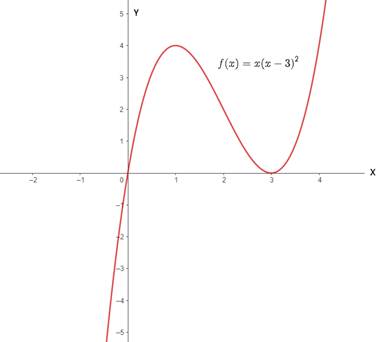
Concept explainers
Find the degree and zeros of the given function.
Explain the multiplicity of zeros and show whether the graph pass through the
Sketch the graph.
The degree of the function is
The zeros of the function
Given:
Find the degree of the function:
Rewrite
Expand
Simplify and combine like terms:
Expand the term:
The largest exponent is the degree of the polynomial, so the degree is
Find the zeros:
To find the zeros, solve the related equation
Apply the zero-factor property:
Hence, the zeros of function
Explain the multiplicity of zeros and show whether the graph pass through the
The graph crosses the
Notice that values of
Sketch the graph:
The graph of the function

Chapter 2 Solutions
Precalculus: Graphical, Numerical, Algebraic Common Core 10th Edition
- 6. The number of viewers of a television series introduced several years ago is approximated by N(t)=(60+2t2/3,1arrow_forwardsolve please, thank youarrow_forwardplease solve, thank youarrow_forwardplease solve, thank youarrow_forwardEvaluate the definite integral using the given integration limits and the limits obtained by trigonometric substitution. 14 x² dx 249 (a) the given integration limits (b) the limits obtained by trigonometric substitutionarrow_forwardAssignment #1 Q1: Test the following series for convergence. Specify the test you use: 1 n+5 (-1)n a) Σn=o √n²+1 b) Σn=1 n√n+3 c) Σn=1 (2n+1)3 3n 1 d) Σn=1 3n-1 e) Σn=1 4+4narrow_forwardanswer problem 1a, 1b, 1c, 1d, and 1e and show work/ explain how you got the answerarrow_forwardProvethat a) prove that for any irrational numbers there exists? asequence of rational numbers Xn converg to S. b) let S: RR be a sunctions-t. f(x)=(x-1) arc tan (x), xe Q 3(x-1) 1+x² x&Q Show that lim f(x)= 0 14x C) For any set A define the set -A=yarrow_forwardQ2: Find the interval and radius of convergence for the following series: Σ n=1 (-1)η-1 xn narrow_forward8. Evaluate arctan x dx a) xartanx 2 2 In(1 + x²) + C b) xartanx + 1½-3ln(1 + x²) + C c) xartanx + In(1 + x²) + C d) (arctanx)² + C 2 9) Evaluate Inx³ dx 3 a) +C b) ln x² + C c)¾½ (lnx)² d) 3x(lnx − 1) + C - x 10) Determine which integral is obtained when the substitution x = So¹² √1 - x²dx sine is made in the integral πT π π a) √ sin cos e de b) √ cos² de c) c Ꮎ Ꮎ cos² 0 de c) cos e de d) for cos² e de πT 11. Evaluate tan³xdx 1 a) b) c) [1 - In 2] 2 2 c) [1 − In2] d)½½[1+ In 2]arrow_forward12. Evaluate ſ √9-x2 -dx. x2 a) C 9-x2 √9-x2 - x2 b) C - x x arcsin ½-½ c) C + √9 - x² + arcsin x d) C + √9-x2 x2 13. Find the indefinite integral S cos³30 √sin 30 dᎾ . 2√√sin 30 (5+sin²30) √sin 30 (3+sin²30) a) C+ √sin 30(5-sin²30) b) C + c) C + 5 5 5 10 d) C + 2√√sin 30 (3-sin²30) 2√√sin 30 (5-sin²30) e) C + 5 15 14. Find the indefinite integral ( sin³ 4xcos 44xdx. a) C+ (7-5cos24x)cos54x b) C (7-5cos24x)cos54x (7-5cos24x)cos54x - 140 c) C - 120 140 d) C+ (7-5cos24x)cos54x e) C (7-5cos24x)cos54x 4 4 15. Find the indefinite integral S 2x2 dx. ex - a) C+ (x²+2x+2)ex b) C (x² + 2x + 2)e-* d) C2(x²+2x+2)e¯* e) C + 2(x² + 2x + 2)e¯* - c) C2x(x²+2x+2)e¯*arrow_forward4. Which substitution would you use to simplify the following integrand? S a) x = sin b) x = 2 tan 0 c) x = 2 sec 3√√3 3 x3 5. After making the substitution x = = tan 0, the definite integral 2 2 3 a) ៖ ស្លឺ sin s π - dᎾ 16 0 cos20 b) 2/4 10 cos 20 π sin30 6 - dᎾ c) Π 1 cos³0 3 · de 16 0 sin20 1 x²√x²+4 3 (4x²+9)2 π d) cos²8 16 0 sin³0 dx d) x = tan 0 dx simplifies to: de 6. In order to evaluate (tan 5xsec7xdx, which would be the most appropriate strategy? a) Separate a sec²x factor b) Separate a tan²x factor c) Separate a tan xsecx factor 7. Evaluate 3x x+4 - dx 1 a) 3x+41nx + 4 + C b) 31n|x + 4 + C c) 3 ln x + 4+ C d) 3x - 12 In|x + 4| + C x+4arrow_forwardarrow_back_iosSEE MORE QUESTIONSarrow_forward_iosRecommended textbooks for you
 Calculus: Early TranscendentalsCalculusISBN:9781285741550Author:James StewartPublisher:Cengage Learning
Calculus: Early TranscendentalsCalculusISBN:9781285741550Author:James StewartPublisher:Cengage Learning Thomas' Calculus (14th Edition)CalculusISBN:9780134438986Author:Joel R. Hass, Christopher E. Heil, Maurice D. WeirPublisher:PEARSON
Thomas' Calculus (14th Edition)CalculusISBN:9780134438986Author:Joel R. Hass, Christopher E. Heil, Maurice D. WeirPublisher:PEARSON Calculus: Early Transcendentals (3rd Edition)CalculusISBN:9780134763644Author:William L. Briggs, Lyle Cochran, Bernard Gillett, Eric SchulzPublisher:PEARSON
Calculus: Early Transcendentals (3rd Edition)CalculusISBN:9780134763644Author:William L. Briggs, Lyle Cochran, Bernard Gillett, Eric SchulzPublisher:PEARSON Calculus: Early TranscendentalsCalculusISBN:9781319050740Author:Jon Rogawski, Colin Adams, Robert FranzosaPublisher:W. H. Freeman
Calculus: Early TranscendentalsCalculusISBN:9781319050740Author:Jon Rogawski, Colin Adams, Robert FranzosaPublisher:W. H. Freeman
 Calculus: Early Transcendental FunctionsCalculusISBN:9781337552516Author:Ron Larson, Bruce H. EdwardsPublisher:Cengage Learning
Calculus: Early Transcendental FunctionsCalculusISBN:9781337552516Author:Ron Larson, Bruce H. EdwardsPublisher:Cengage Learning
 Calculus: Early TranscendentalsCalculusISBN:9781285741550Author:James StewartPublisher:Cengage Learning
Calculus: Early TranscendentalsCalculusISBN:9781285741550Author:James StewartPublisher:Cengage Learning Thomas' Calculus (14th Edition)CalculusISBN:9780134438986Author:Joel R. Hass, Christopher E. Heil, Maurice D. WeirPublisher:PEARSON
Thomas' Calculus (14th Edition)CalculusISBN:9780134438986Author:Joel R. Hass, Christopher E. Heil, Maurice D. WeirPublisher:PEARSON Calculus: Early Transcendentals (3rd Edition)CalculusISBN:9780134763644Author:William L. Briggs, Lyle Cochran, Bernard Gillett, Eric SchulzPublisher:PEARSON
Calculus: Early Transcendentals (3rd Edition)CalculusISBN:9780134763644Author:William L. Briggs, Lyle Cochran, Bernard Gillett, Eric SchulzPublisher:PEARSON Calculus: Early TranscendentalsCalculusISBN:9781319050740Author:Jon Rogawski, Colin Adams, Robert FranzosaPublisher:W. H. Freeman
Calculus: Early TranscendentalsCalculusISBN:9781319050740Author:Jon Rogawski, Colin Adams, Robert FranzosaPublisher:W. H. Freeman
 Calculus: Early Transcendental FunctionsCalculusISBN:9781337552516Author:Ron Larson, Bruce H. EdwardsPublisher:Cengage Learning
Calculus: Early Transcendental FunctionsCalculusISBN:9781337552516Author:Ron Larson, Bruce H. EdwardsPublisher:Cengage Learning